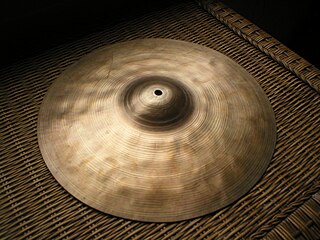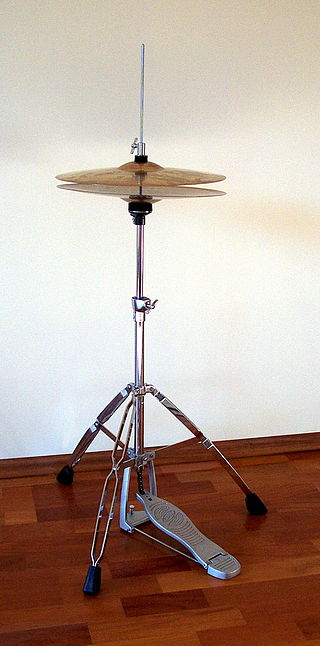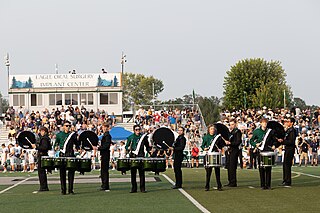
A cymbal is a common percussion instrument. Often used in pairs, cymbals consist of thin, normally round plates of various alloys. The majority of cymbals are of indefinite pitch, although small disc-shaped cymbals based on ancient designs sound a definite note. Cymbals are used in many ensembles ranging from the orchestra, percussion ensembles, jazz bands, heavy metal bands, and marching groups. Drum kits usually incorporate at least a crash, ride, or crash/ride, and a pair of hi-hat cymbals. A player of cymbals is known as a cymbalist.

The drum is a member of the percussion group of musical instruments. In the Hornbostel-Sachs classification system, it is a membranophone. Drums consist of at least one membrane, called a drumhead or drum skin, that is stretched over a shell and struck, either directly with the player's hands, or with a percussion mallet, to produce sound. There is usually a resonant head on the underside of the drum. Other techniques have been used to cause drums to make sound, such as the thumb roll. Drums are the world's oldest and most ubiquitous musical instruments, and the basic design has remained virtually unchanged for thousands of years.

A drum kit is a collection of drums, cymbals, and sometimes other auxiliary percussion instruments set up to be played by one person. The drummer typically holds a pair of matching drumsticks, and uses their feet to operate hi-hat and bass drum pedals.

A hi-hat is a combination of two cymbals and a pedal, all mounted on a metal stand. It is a part of the standard drum kit used by drummers in many styles of music including rock, pop, jazz, and blues. Hi-hats consist of a matching pair of small to medium-sized cymbals mounted on a stand, with the two cymbals facing each other. The bottom cymbal is fixed and the top is mounted on a rod which moves the top cymbal toward the bottom one when the pedal is depressed.

A percussion instrument is a musical instrument that is sounded by being struck or scraped by a beater including attached or enclosed beaters or rattles struck, scraped or rubbed by hand or struck against another similar instrument. Excluding zoomusicological instruments and the human voice, the percussion family is believed to include the oldest musical instruments. In spite of being a very common term to designate instruments, and to relate them to their players, the percussionists, percussion is not a systematic classificatory category of instruments, as described by the scientific field of organology. It is shown below that percussion instruments may belong to the organological classes of idiophone, membranophone, aerophone and cordophone.

A drummer is a percussionist who creates music using drums.

The bass drum is a large drum that produces a note of low definite or indefinite pitch. The instrument is typically cylindrical, with the drum's diameter much greater than the drum's depth, with a struck head at both ends of the cylinder. The heads may be made of calfskin or plastic and there is normally a means of adjusting the tension either by threaded taps or by strings. Bass drums are built in a variety of sizes, but size does not dictate the volume produced by the drum. The pitch and the sound can vary much with different sizes, but the size is also chosen based on convenience and aesthetics. Bass drums are percussion instruments and vary in size and are used in several musical genres. Three major types of bass drums can be distinguished.
A blast beat is a type of drum beat that originated in hardcore punk and grindcore, and is often associated with certain styles of extreme metal, namely black metal and death metal, and occasionally in metalcore. In Adam MacGregor's definition, "the blast-beat generally comprises a repeated, sixteenth-note figure played at a very fast tempo, and divided uniformly among the bass drum, snare, and ride, crash, or hi-hat cymbal." Blast beats have been described by PopMatters contributor Whitney Strub as, "maniacal percussive explosions, less about rhythm per se than sheer sonic violence".
"The 'original' or traditional blastbeat is a single-stroke roll played between your cymbal and snare, with your kick playing simultaneously with every cymbal hit."

Clash cymbals are cymbals played in matched pairs by holding one cymbal in each hand and striking the two together.

Marching percussion instruments are percussion instruments specially designed to be played while moving. This is achieved by attaching the drum(s) to a special harness worn by the drummer, although not all marching bands use such harnesses and instead use traditional baldrics to sling their drums.

Electronic drums are a modern electronic musical instrument, primarily designed to serve as an alternative to an acoustic drum kit. Electronic drums consist of an electronic sound module which produces the synthesized or sampled percussion sounds and a set of pads, usually constructed in a shape to resemble drums and cymbals, which are equipped with electronic sensors to send an electronic signal to the sound module which outputs a sound. Like acoustic drums, the pads are struck by drum sticks and they are played in a similar manner to an acoustic drum kit, albeit with some differences in the drumming experience.
Drum tablature, commonly known as a drum tab, is a form of simplified percussion notation, or tablature for percussion instruments. Instead of the durational notes normally seen on a piece of sheet music, drum tab uses proportional horizontal placement to indicate rhythm and vertical placement on a series of lines to represent which drum from the drum kit to stroke. Drum tabs frequently depict drum patterns.

Carter Anthony Beauford is an American drummer, percussionist, and founding member of Dave Matthews Band. He is known for his ability to adapt to a variety of genres, and both his ambidextrous and his open-handed drumming styles. He plays the drums and sings backing vocals in the band. Beauford was ranked number 10 by a Rolling Stone magazine reader's poll in 2010 for greatest drummers of all-time.
Heel-toe technique is a foot technique that drummers use to be able to play single strokes or double strokes on the bass drum, hi-hat, or other pedals.

Pacific Drums and Percussion is a musical instrument brand established by the Drum Workshop Inc., in 1999, with the purpose of providing its percussion instruments at more affordable prices.

James Patrick Keeler is an American rock music drummer from Cincinnati, who is best known for playing in The Greenhornes, The Raconteurs, and The Afghan Whigs. He plays with both traditional and matched grips.
Open-handed drumming refers to a method of playing a drum kit.

Drum hardware is the set of parts of a drum or drum kit that are used to tension, position, and otherwise support the instruments themselves.
Walberg and Auge is a United States drum kit and hardware manufacturer established in 1903 in Worcester, Massachusetts by Barney Walberg. Walberg and Auge is considered by some to be, "the biggest unknown name in the history of twentieth-century American percussion." The brand is credited with several innovations in musical instruments and associated hardware including the development of the modern hi-hat stand and shell-mounted tom-tom holder. The magazine Modern Drummer detailed the origin story of the modern hi-hat configuration: "After months of experimenting, Walberg's company extended the inner rod and outer tube of his low hat stand to about waist high so he could play the cymbals with his hand as well as his feet." The pivotal innovation was sold by every major drum company under the rubric "Perfection Hats."

Heavy metal drumming is a style of rock music drum kit playing that developed in the late 1960s and early 1970s, largely in the United States and the United Kingdom. With roots in blues rock and psychedelic/acid rock drum playing, heavy metal drummers play with emphatic beats, and overall loudness using an aggressive performing style. Heavy metal drumming is traditionally characterized by emphatic rhythms and dense bass guitar-and-drum sound.














